Vector Field Processing
on Triangle Meshes
Course Notes
ACM SIGGRAPH Asia 2015
ORGANIZERS:
FERNANDO DE GOES
Pixar Animations Studios
MATHIEU DESBRUN
Caltech
YIYING TONG
Michigan State University
�
Abstract
While scalar fields on surfaces have been staples of geometry processing, the use of
tangent vector fields has steadily grown in geometry processing over the last two
decades: they are crucial to encoding directions and sizing on surfaces as commonly
required in tasks such as texture synthesis, non-photorealistic rendering, digital
grooming, and meshing. There are, however, a variety of discrete representations of
tangent vector fields on triangle meshes, and each approach offers different trade-
offs among simplicity, efficiency, and accuracy depending on the targeted application.
This course reviews the three main families of discretizations used to design
computational tools for vector field processing on triangle meshes: face-based,
edge-based, and vertex-based representations.
In the process of reviewing the
computational tools offered by these representations, we go over a large body of
recent developments in vector field processing in the area of discrete differential
geometry. We also discuss the theoretical and practical limitations of each type of
discretization, and cover increasingly-common extensions such as n-direction and
n-vector fields.
While the course will focus on explaining the key approaches to practical encoding
(including data structures) and manipulation (including discrete operators) of finite-
dimensional vector fields, important differential geometric notions will also be
covered: as often in Discrete Differential Geometry, the discrete picture will be
used to illustrate deep continuous concepts such as covariant derivatives, metric
connections, or Bochner Laplacians.
�
Preface
T hese course notes provide a review of the various representations of tangent vector fields
on triangulated surfaces. Over the past decades, a number of approaches to express, design,
and analyze vector fields on arbitrary meshes have been proposed in geometry processing,
targeting a series of applications varying from rendering to animation. Some describe vector
fields through values on vertices, some on edges, and some on faces; some treat vector fields as piecewise
constant, some as piecewise linear, and some even involve non-linear finite elements. This lack of a
unified approach to vector field representation and manipulation can be confusing for practitioners, and
rare are the references that discuss the pros and cons of these various representations. The chapters in
this document were written with this fact in mind, as a way to offer an introduction to the motivations,
benefits, and shortcomings of the most common discretizations of vector fields in graphics—along with
their associated discrete differential operators (curl, divergence, Laplacian, etc). Emphasis is placed
on the tradeoffs between simplicity, efficiency, and accuracy of these geometry processing tools for
applications ranging from texture synthesis to meshing.
In many ways, this course is a continuation of ACM SIGGRAPH courses on
Course rationale.
Discrete Differential Geometry (SIGGRAPH ’05 and ’06, and SIGGRAPH Asia ’09) and Discrete
Exterior Calculus (SIGGRAPH ’13) taught over the past decade. Nevertheless, it does not require
familiarity with these former courses. The course will, instead, introduce topics absent from previous
offerings such as connections, covariant derivatives, and interpolating basis functions for vector fields—
which are gaining popularity among practitioners, but for which no tutorials are available. The notes
are intended for graduate students, researchers, and developers interested in geometry processing.
Practitioners will find concrete data structures and numerical tools for the manipulation of vector fields
on triangle surfaces, while scholars will learn how to preserve geometrical and topological continuous
properties in the finite-dimensional realm.
Pedagogical Intentions. These course notes were conceived to complement a half-day course at
SIGGRAPH Asia ’15, so we mostly mirrored its three-part structure, reviewing works where vector
fields are stored per face first, then describing those using per-edge representation, then finally going
over the more difficult case of per-vertex encoding. For each representation, we provide its essential
mathematical background as well as a few examples of real-world applications. The course material
aims at providing not only a literature review of the field of vector field processing, but also to introduce
basic geometric concepts that the field of differential geometry has developed to provide a principled
approach to vector calculus on arbitrary manifolds. The theme of discrete differential geometry (i.e.,
finite dimensional approximations that respect key properties of their infinite-dimensional counterparts)
will be omnipresent in the course, and numerical advantages and limitations will be highlighted, often
using concrete applications for better illustration. As a consequence, the material should be accessible
to anyone who has had exposure to basic linear algebra and vector calculus. A basic understanding of
differential geometry is also recommended, but not mandatory. Throughout these notes, we strived to
present each mathematical concept using a concrete geometric picture; we punt most of the associated
abstract or algebraic arguments to existing references for the readers who want to get a more thorough
exposition.
Credit where credit is due. We are indebted to our coauthors for the material included in [Tong et al.
2003; Wang et al. 2006; Fisher et al. 2007; Hertzmann and Zorin 2000; Crane et al. 2010; Crane et al.
2013; de Goes et al. 2014; Liu et al. 2015]. We also thank the attendants of our previous classes for their
feedback by which our approach was informed.
�
Introduction to Discrete Vector Fields
1 Vector fields in geometry processing
Before delving into the technical details of how vector fields are encoded in traditional geometry
processing methods, we provide some background on the relevance and difficulties of discrete vector
fields in graphics.
1.1 Motivation
Numerous applications in computer graphics need to manipulate tangent vector
fields on triangle meshes. For instance, example-based texture synthesis needs a
vector field to define the texture’s local orientation and scale. Non-photorealistic
rendering often renders brush strokes and hatches along a vector field as well.
Fur in computer-generated movies is typically derived from an artist-designed
vector field to indicate hair direction and length (see inset). Vector fields can also
be used to derive a quad mesh for which edges align to the local direction and
scale of the field. Even animation can benefit from the notion of vector fields
since they are the main physical variable to simulate all sorts of fluid motion
on geometric domains. Finally, it is important to point out that vector fields are
the simplest members of the more general notion of n-vector fields (also called
n-rotational symmetry or n-RoSy fields) and n-direction fields (unit n-vector
fields), which include direction (n = 1), line (n = 2) and cross (n = 4) fields. As
such, knowing how to manipulate vector fields on surfaces often generalizes to
more general fields without significant changes.
1.2 A first look at discrete vector fields
cPixar/Disney
Defining a tangent vector field on a triangulated surface is indubitably more involved than a scalar
function. First, the very fact that each vector is supposed to be within a tangent plane is at odds with the
fact that a triangle mesh does not even have a clear, canonical definition of a tangent space for points
along an edge or at a vertex. Second, one could think that it is as simple as storing two scalar fields,
one for each coordinate; but that would be assuming that one has previously defined a notion of local
coordinate frame at every point on the surface—a difficult task in itself as it involves parameterization
and defining two basis vector fields over the parameterization chart! No surprise, then, that there exist
multiple ways of encoding a vector field over a mesh.
Moreover, a vector field can contain a number of singularities, which often require careful handling in
practical applications. For a scalar field, there are also special points, easily identified as local maxima,
local minima, or saddle points; but the catalog of singularities for vector fields is now more involved.
In fact one can define the index for a singularity that basically measures the angular variation of the
vector field around a singularity (i.e., the number of times it coils around). Moreover, the sum of these
indices for an arbitrary vector field must be fixed for a given surface. That is to say, you cannot ask a
vector field for too much: the topology of the surface over which then tangent vector field is defined
will force some global behavior. This is what the “hairy ball theorem” [Eisenberg and Guy 1979] states:
you simply cannot comb a sphere without creating at least one cowlick somewhere; yet you can comb a
�
doughnut, as these two geometric objects differ in topology. Geometry and topology of vector fields are
thus intimately linked...
Since we usually seek smooth-looking vector fields, we also need to define a notion of smoothness
that is intuitive, both quantitatively (so that we can objectively refer to a vector field as being smoother
than another) and visually (so that it looks nice in the “eyeball norm” as well). While smoothness and
derivatives of scalar functions are typically high school topics, derivatives of vector fields on non-flat
surfaces are more involved, and a few specific definitions of derivatives will be relevant for the design of
vector fields. Only then can a user expect to turn a sparse set of constraints (prescribing alignment and
magnitude) into a smooth vector field automatically fitting these input constraints—thus making the
process of designing a vector field simple, intuitive, and hopefully fast.
1.3 Representations
Since the choice of smoothness and input constraints depends very much on how vector fields are defined
over a triangle mesh, we must first and foremost decide on a finite-dimensional representation of vector
fields over the underlying surface. Such representations are often grounded in differential geometry, and
will serve as the principles for the discretization of tangent vector fields on triangle meshes.
In R2, we are used to manipulate vector fields as a set of two coordinates per point associated to a global
coordinate system. Note that these coordinates depend on the choice of a basis, so the vector field is only
encoded via coordinates. Yet the field itself is a geometrical object that retains its own identity regardless
of how one chooses to describe it in a basis. For tangent vector fields on a non-flat surface, one cannot
use a single coordinate frame; instead, one is required to define a coordinate frame for each tangent plane
(possibly through charts) if one wishes to retain the two-coordinate representation of vector fields—and
we will see that, fortunately, a triangle mesh provides ample opportunities to define local frames. A
vector field then becomes an assignment of a tangent vector to each point on a manifold surface. In the
language of fiber bundles1, a vector field is thus a section of the tangent bundle, in the sense that from all
the tangent vectors associated to each point of the manifold, we pick a particular one, and this choice of
tangent vector per surface point defines a vector field. Existing discrete representations of vector fields
mimic this fiber bundle point of view as we will review in these notes.
One can also do away with coordinates altogether. We will show that one can sample a vector field, much
like one can sample a scalar field and, from these samples, a reconstruction of the original field can be
found. Other ways to think of vector fields on manifolds in the continuous setting can also be leveraged
to derive discrete representations. For instance, vector fields can be characterized as derivations of
smooth functions on a manifold using directional derivative; this has led to an operator representation of
vector fields, used first in fluid animation [Mullen et al. 2009; Pavlov et al. 2011; Gawlik et al. 2011],
and more recently in geometry processing [Azencot et al. 2013; Azencot et al. 2015].
1.4 Vector calculus
Many of the elements of differential and integral calculus extend to vector fields quite naturally, but can
involve advanced geometric notions. A particularly difficult endeavor in vector calculus over surfaces is
how to talk about the difference between two nearby tangent vectors: while this notion is trivial in a flat
space where coordinates in a common basis can be used, we have to find a proper geometric approach to
define it on a curved domain. A covariant derivative introduces such an extra geometric structure on a
manifold which allows vectors in neighboring tangent spaces to be compared. This extra structure is
1The term fiber bundle can be intuitively understood by thinking of it as a hairbrush: for each point of a
base space (cylinder), there is a vector space (bristle) associated to it. A fiber bundle is thus a way of knitting
together several spaces to create a bigger space. By picking a particular point on the bristle at each point of the
base manifold in a continuous fashion, we construct a (cross-)section of the hairbrush (in our context, a vector
field—but the same holds for any fiber field).
�
necessary since there is no canonical way to compare vectors from different vector spaces. Covariant
differentiation also helps to define the notion of parallel transport along a path, the analog of a translation
in R2. Working with a connection on the tangent bundle (to compare two nearby tangent vectors, and
thus induce a covariant derivative) will eliminate the need for awkward manipulations of Christoffel
symbols traditionally found in differential geometry. Our course notes review various approximations
of these notions, and as one might expect from any numerical treatment, various tradeoffs between
simplicity and accuracy will be provided.
2 Overview
The core of these course notes is made of three chapters, each reviewing one particular vector field
representation on triangle meshes. By design, each chapter is essentially independent of the others.
However, the order in which these chapters are presented was decided based on the complexity of the
material. The reader can thus decide whether to read the chapters sequentially, or directly skip to the
material most relevant to her.
2.1 A chapter-by-chapter synopsis
Existing geometry processing methods generally use one of three different encoding of vector fields. We
review them one by one, contrasting their pluses and minuses.
Face-based vector fields. The first part of the course focuses on piecewise-constant vector fields per
triangle. As a triangle is flat, it is particularly convenient to define a tangent vector on its supporting
plane. Even with jumps between faces, we will be able to define discrete notions of divergence, curl, or
even Laplacian of these vector fields, and we will point out that each vector field can be decomposed
into curl- and divergence-free components using (plain or mixed) finite elements. We will also introduce
a very simple discrete notion of connection, corresponding to a single angle for every pair of adjacent
triangles, as an alternative way to think of the vector field which extends to arbitrary n-vector fields.
Edge-based vector fields. The second part of the course discusses the use of edge integration (i.e.,
line integral) to represent a discrete vector field. We review how these edge values can, through
piecewise-linear Whitney basis functions, be interpolated into vector fields or, equivalently, covector
fields. This approach produces locally linear vector fields, although normal continuity across edges is
not guaranteed. Nevertheless, discrete differential operators can be easily derived and computed just like
in the previous case, from which one can easily design vector fields in realtime on triangle meshes.
Vertex-based vector fields. The third and last part then reviews recent approaches encoding vector
fields using vertex-based non-linear basis functions. By thinking of the one-ring of a vertex as a chart, a
continuous vector field can be defined on an arbitrary triangle mesh, from which operators such as the
divergence, curl, and covariant derivative can be directly derived. This will even allow us to define the
notion of smoothest n-vector and n-direction field for a surface, which will correspond to a generalized
eigenvalue problem.
The reader will have noticed that the ordering also corresponds to various orders of continuity—from
discontinuous to continuous—of the discrete representations. It also, coincidentally, involves increasingly
complex computational tools to evaluate differential operators in a weak form on these vector fields.
2.2 Applications
Applications using vector fields as input or guidance are legion. As our course focuses on the underlying
representation of vector fields, we made no effort to review thoroughly the numerous geometry processing
applications that each representation has been used in. Instead, we weaved examples of non-photo
realistic rendering, quad meshing, or vector field design in every chapter to provide a more thorough
�
description of the use of each representation. The reader interested in a broader perspective on these
applications is referred to the numerous books and courses on geometry processing.
2.3 Notations
Throughout these notes, we assume that we are working with a triangle mesh, approximating a smooth
surface, that is of arbitrary topology, orientable, compact, and 2-manifold (possibly with boundary). We
denote its vertex set V ={vi}, its edge set E ={eij} and its triangle set T ={tijk} (1≤ i, j, k ≤ n =
|V |). Each triangle is counterclockwise oriented and each edge carries an arbitrary but fixed intrinsic
orientation. Note that index order matters since eij has opposite orientation from eji, and similarly for
triangles. Vertices are given positions P ={pv ∈R3|v∈ V }, which define the surface through piecewise
linear interpolation over each triangle, so that pij = pj−pi represents the edge as a segment in R3. The
intrinsic volumes of edges and triangles will be denoted |e| (length) and |t| (area), and we assume these
are all nonzero, i.e., there are no degenerate edges. For a vertex, we define |v| = 1. We also assign a
(lumped) area per edge and vertex: aij is one third of the triangle areas incident to eij, and ai is one third
of the one-ring area. Moreover, we indicate αjki as the angle of the triangle tijk at vertex vk, so that the
αkij. Finally, we denote
discrete Gaussian curvature κi of vertex vi is the angle defect κi = 2π−
the imaginary number as i when we use complex numbers.
3 Differential geometry primer for vector fields
tijk
In this section, we tersely review some key continuous geometric notions that will come up in these
notes. While these notions can be introduced in various ways, we focus as much as possible on intrinsic
definitions to provide a very geometric explanation of their meaning. For more details, see, e.g.,
[Abraham et al. 1988]. The reader is invited to refer back to this primer when the discretization of
operators is discussed during the class, to better understand how the discrete and differential viewpoints
coincide—yet sometimes differ.
3.1 Tangent Vector Fields
Consider a compact topological 2-manifold M, covered by a collection (atlas) of charts that have C∞
smooth transition functions between each overlapping pair (which always exists [Grimm and Hughes
1995]). The notion of tangent planes and vectors can be defined intrinsically (i.e., independent of the
embedding of the manifold in a Euclidean space) via, for instance, the tangency among smooth curves
passing through a common point.
Definition 1 ([Abraham et al. 1988]). Let x = (x1, x2) be a local chart mapping an open set U⊂M to
R2. A smooth curve c passing through a point p∈ U is a map c : I → U for which the interval I ⊂ R
contains 0, c(0) = p, and x ◦ c is C 2. Two smooth curves c1 and c2 are said to be tangent at p if and
only if
(1)
(x ◦ c1)(0) = (x ◦ c2)(0).
Note that this definition of tangency is independent of the choice of charts. Tangent curves can thus be
used as an equivalence relation defining intrinsic vector spaces tangent to M.
Definition 2 ([Abraham et al. 1988]). A tangent vector at p∈ M is the equivalence class [c]p of curves
tangent to curve c at p. The space of tangent vectors is called the tangent space at p, denoted as TpM.
The tangent bundle is the (disjoint) union of tangent spaces T M = ∪p∈M TpM.
When the surface M has an embedding in R3, one can further express the tangent vectors as 3D vectors
orthogonal to the surface normal, as classically explained in differential geometry of surfaces. Observe
that the tangent space TpM at any point p∈ M is two dimensional and a tangent vector u = [c]p can
�
be represented in components as (u1, u2) = ((x1 ◦ c)(0), (x2 ◦ c)(0)) given a chart x. Thus, the tan-
gent bundle T M admits the structure of a 4-manifold with charts (x1, x2, u1, u2) induced by the atlas of M.
Definition 3 ([Abraham et al. 1988]). A (tangent) vector field u is a continuous map M → T M from
a point p∈ M to a vector u(p)∈ TpM. A local frame field of M on a chart is defined as two vector
fields (e1, e2) that are linearly independent pointwise.
Global frame fields do not exist in general, otherwise one could build a continuous vector field that is
nonzero everywhere on a genus-0 surface, thus contradicting the hairy ball theorem [Eisenberg and Guy
1979]. Consequently, T M does not usually have the structure of M×R2, even though on a chart U, T U
does have the structure of U×R2. On a chart with a local frame field, a vector field u can be expressed
in components as
u = u1e1 + u2e2.
(2)
The aforementioned chart of T M can be seen as a special case of the component representation, with ei
(often denoted as ∂/∂xi) being the equivalence class of the curves generated by varying coordinate xi
while keeping the other coordinate fixed.
Definition 4 ([Abraham et al. 1988]). A covector ω at p is defined as a linear map ω : TpM → R. The
space of covectors is a linear space itself, denoted as T ∗
One can likewise define smooth fields of covectors, which are also called (differential) 1-forms. They
can be represented in local bases (η1, η2) defined by ηi(ej) = δi
One can also augment a surface M with a metric by assigning an inner product (symmetric positive
definite bilinear mapping) ·,·p for every tangent space TpM—e.g., for an embedded surface, it can be
defined by the inner product of the corresponding 3D vectors in the 3D Euclidean space.
Finally, we point out that the directional derivative of a function f over M w.r.t. a vector u = [c]p∈ TpM
is defined as (f◦c)(0), corresponding to df (u) in the language of differential forms and to the more
familiar inner product ∇f, u when a metric is available [Abraham et al. 1988].
3.2 Covariant Derivative
j given a frame field (e1, e2).
pM.
In order to take derivatives of vector fields, one must account for the fact that vectors in nearby tangent
spaces are expressed on different local frames. The concept of covariant differentiation, denoted ∇,
provides a principled way to compare nearby tangent vectors and measure their differences. The basic
geometric intuition behind the covariant derivative of a vector field u at a point p is that ∇u encodes
the rate of change of u around p. Projecting the derivative of a vector field u along a vector w leads
to a vector ∇wu, which indicates the difference between vectors u(p) at p and u(q) at a nearby point
q≡ c(�), where c is a curve passing through p in the equivalence class w, and �∈R is approaching zero
(Fig. 1). However, these vectors live in different tangent spaces, so the component-wise differences
depend on the choice of local basis frames, and taking their differences in a manner that is purely in-
trinsic (i.e., coordinate/frame independent) requires the additional notion of connection as we now review.
Definition 5 ([Spivak 1979]). A covariant derivative (or an affine connection) is an operator ∇
mapping a vector w∈ TpM and a vector field u to a vector ∇wu∈ TpM, so that it is linear in both u
and w and satisfies Leibniz’s product rule, i.e., for a vector field u and a smooth function f, one has
∇w(f u) = df (w)u + f∇wu.
Using the representation of the vector field u in a local frame field (e1, e2), we can expand the covariant
derivative through linearity and product rule in u as:
dui(w)ei + ui∇wei
,
i=1,2
∇wu =
�
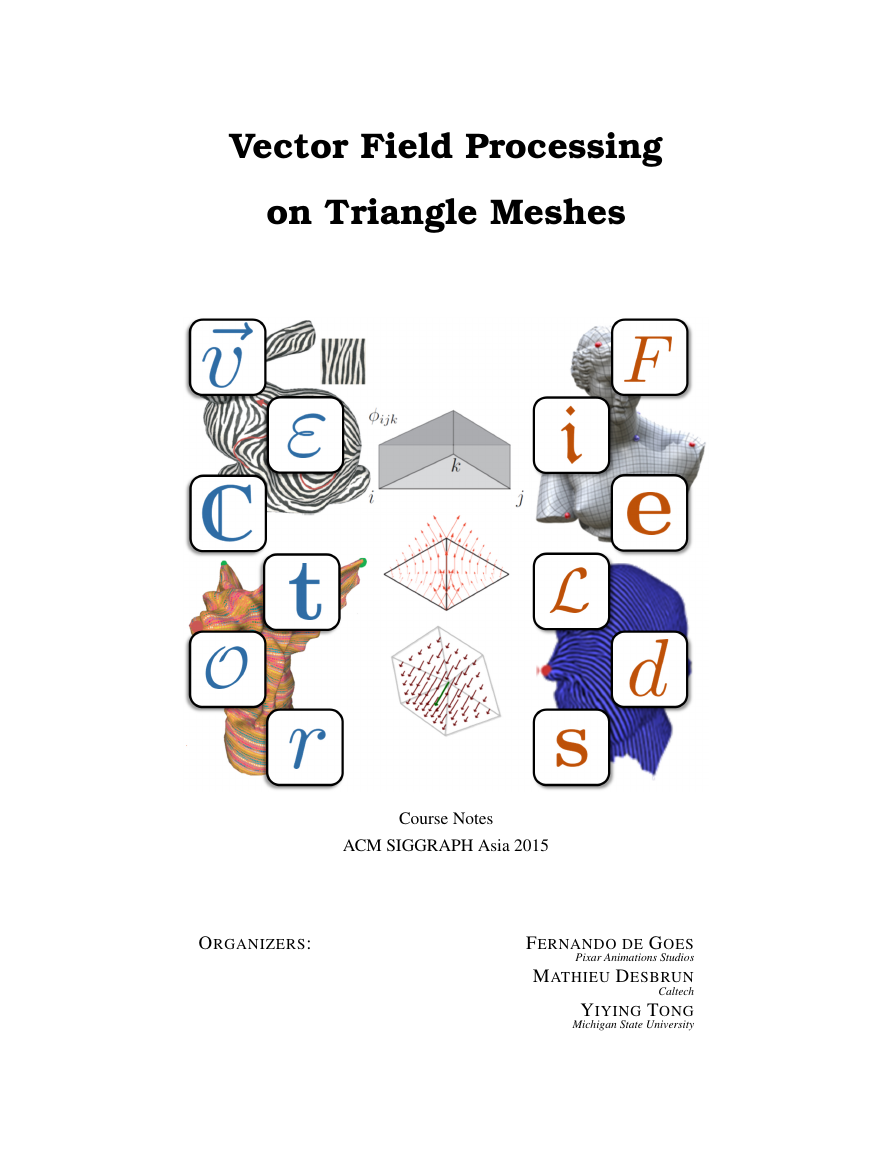
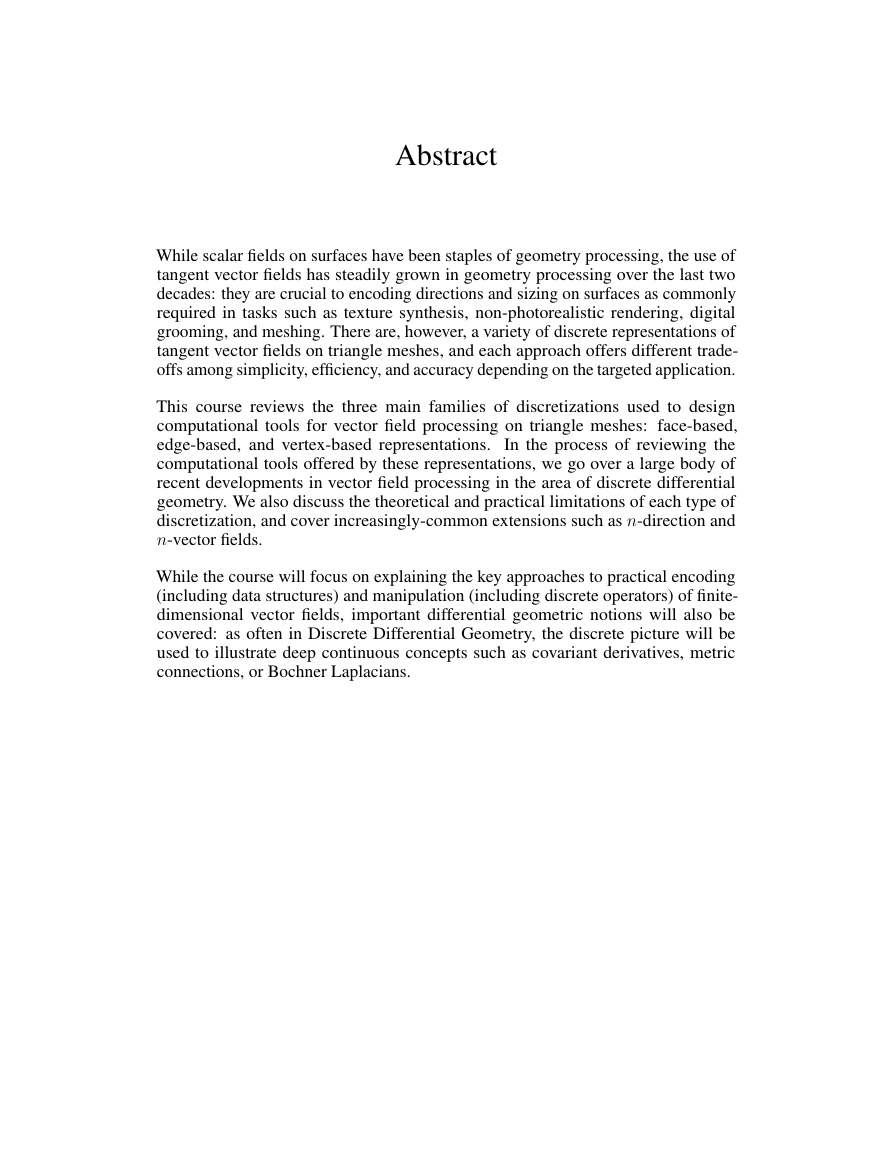
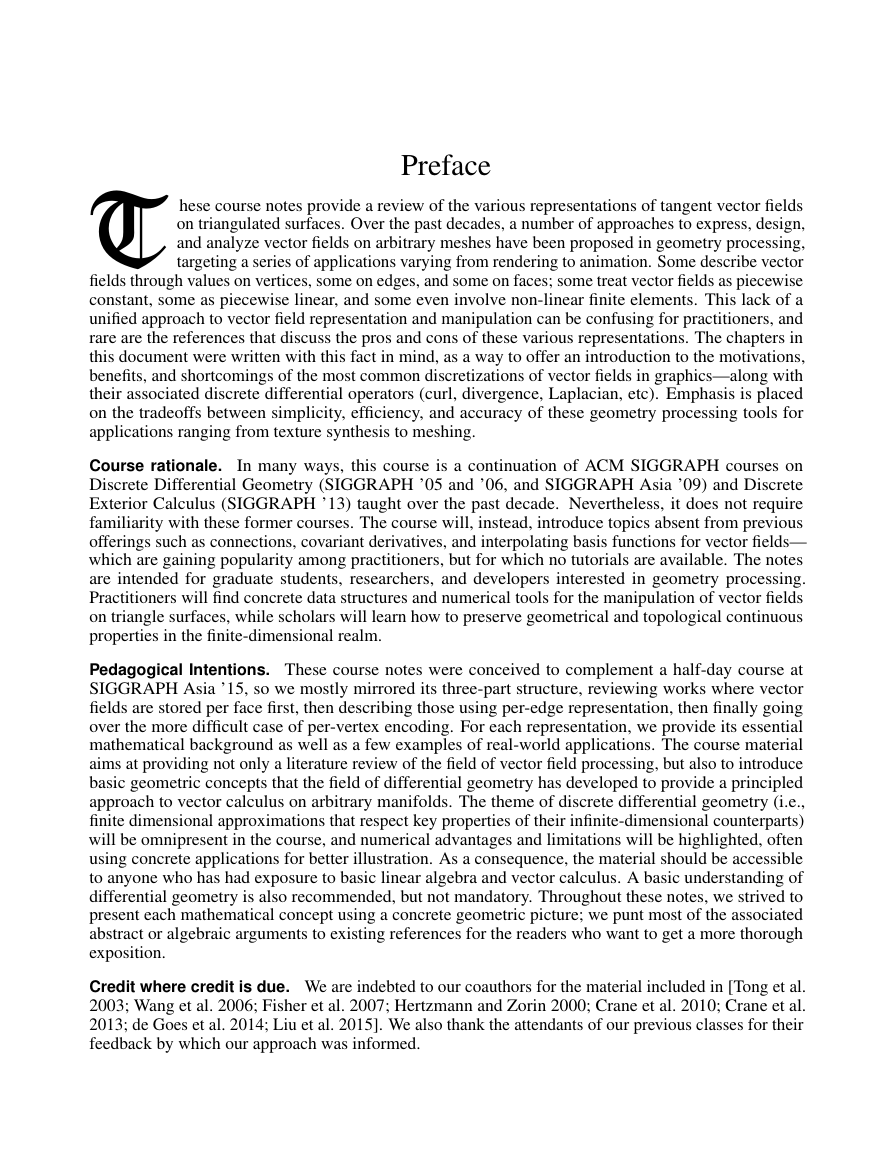
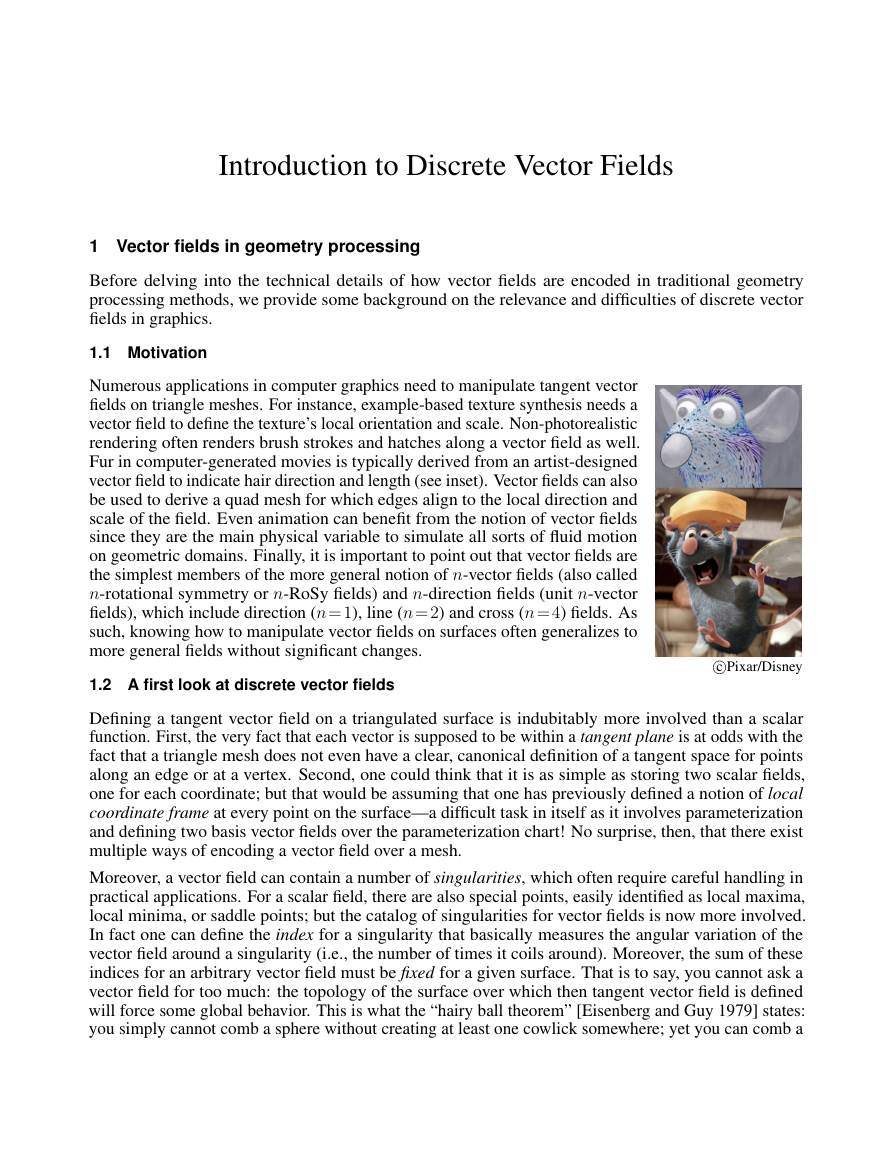
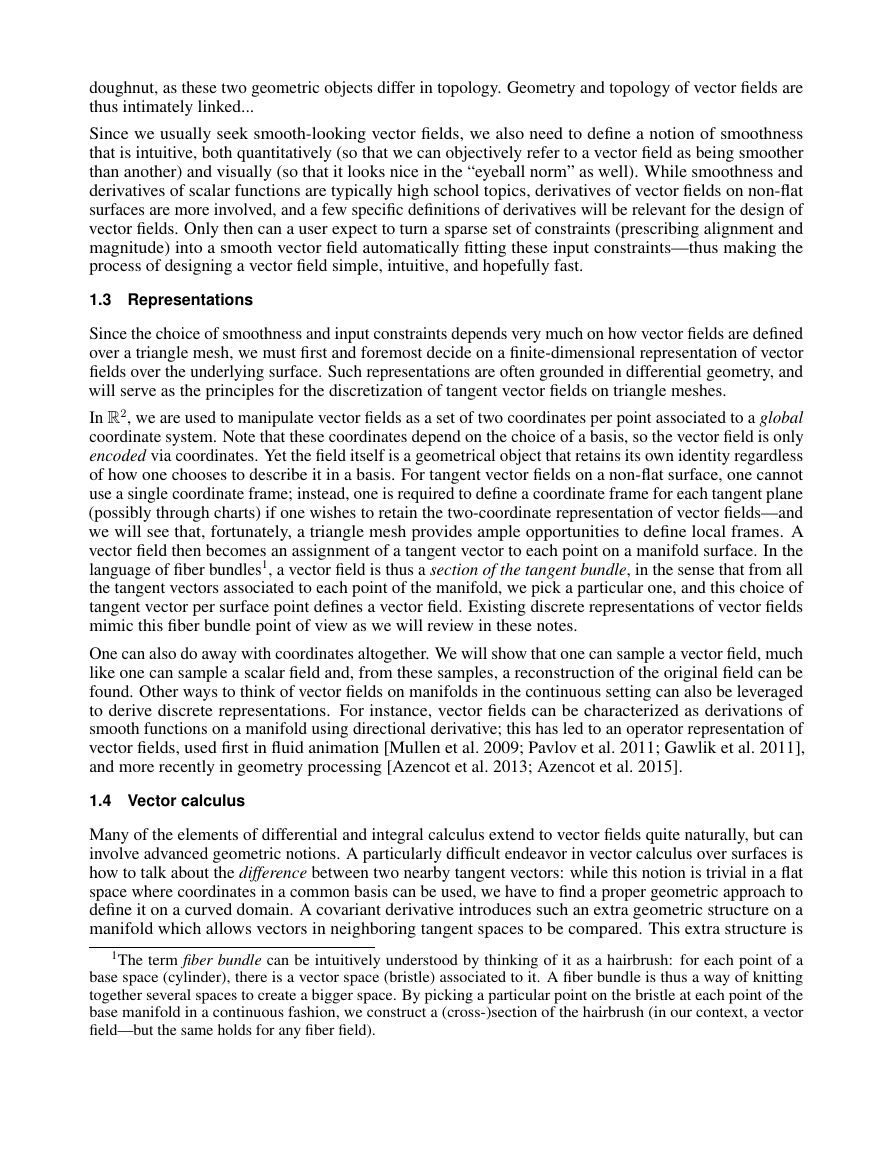
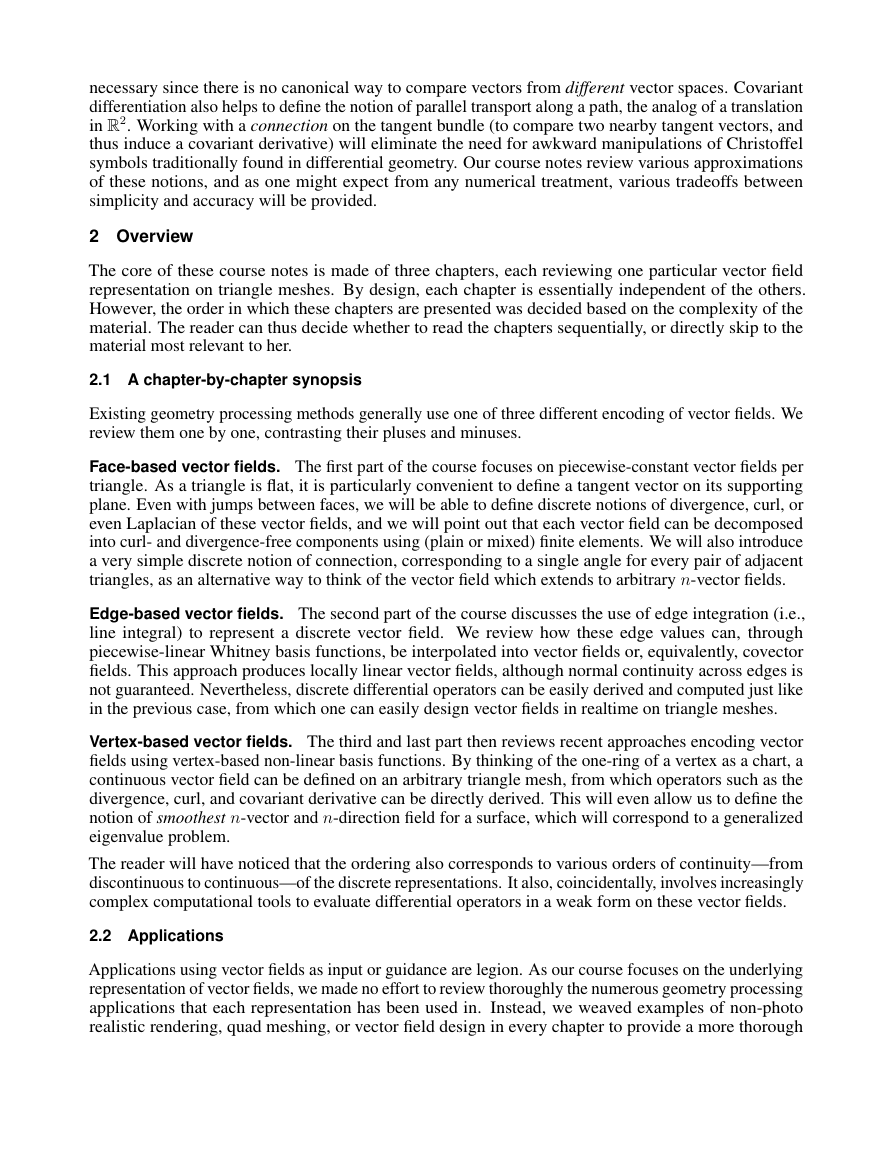
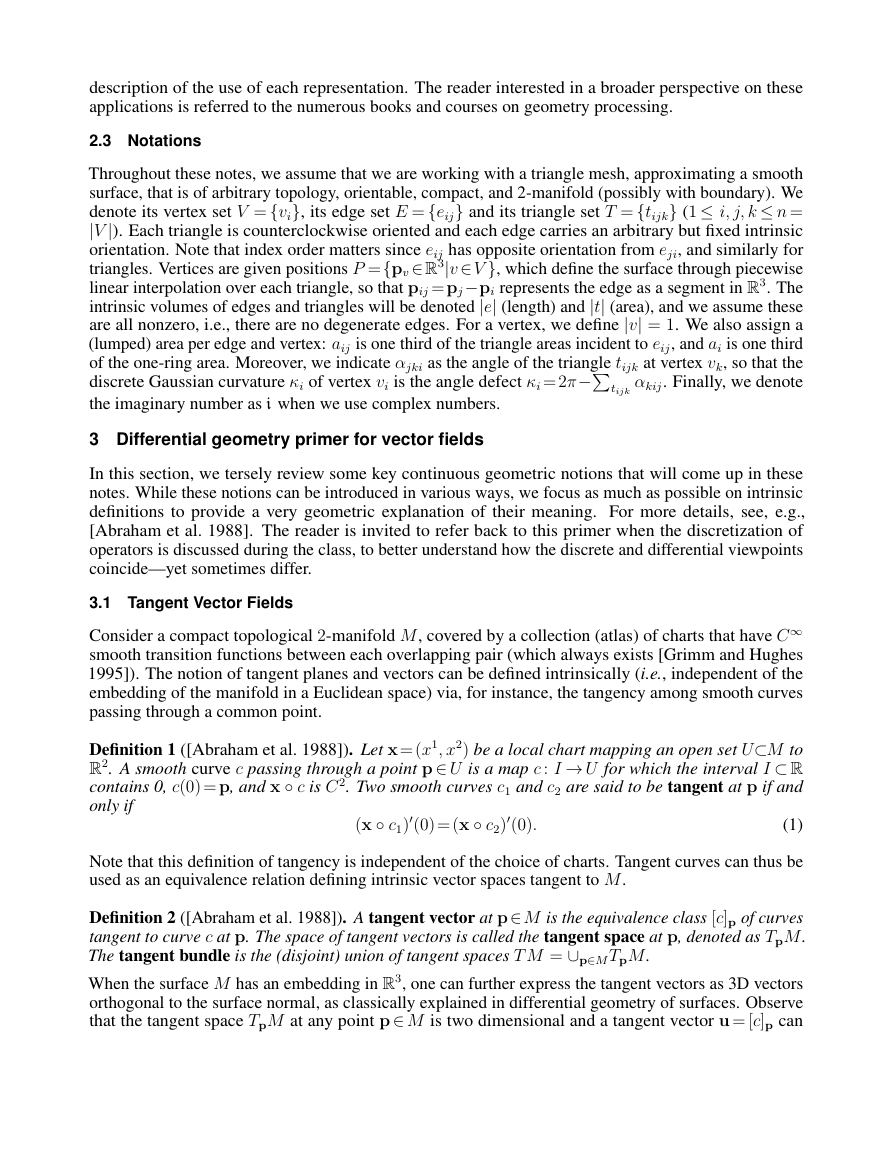









 2023年江西萍乡中考道德与法治真题及答案.doc
2023年江西萍乡中考道德与法治真题及答案.doc 2012年重庆南川中考生物真题及答案.doc
2012年重庆南川中考生物真题及答案.doc 2013年江西师范大学地理学综合及文艺理论基础考研真题.doc
2013年江西师范大学地理学综合及文艺理论基础考研真题.doc 2020年四川甘孜小升初语文真题及答案I卷.doc
2020年四川甘孜小升初语文真题及答案I卷.doc 2020年注册岩土工程师专业基础考试真题及答案.doc
2020年注册岩土工程师专业基础考试真题及答案.doc 2023-2024学年福建省厦门市九年级上学期数学月考试题及答案.doc
2023-2024学年福建省厦门市九年级上学期数学月考试题及答案.doc 2021-2022学年辽宁省沈阳市大东区九年级上学期语文期末试题及答案.doc
2021-2022学年辽宁省沈阳市大东区九年级上学期语文期末试题及答案.doc 2022-2023学年北京东城区初三第一学期物理期末试卷及答案.doc
2022-2023学年北京东城区初三第一学期物理期末试卷及答案.doc 2018上半年江西教师资格初中地理学科知识与教学能力真题及答案.doc
2018上半年江西教师资格初中地理学科知识与教学能力真题及答案.doc 2012年河北国家公务员申论考试真题及答案-省级.doc
2012年河北国家公务员申论考试真题及答案-省级.doc 2020-2021学年江苏省扬州市江都区邵樊片九年级上学期数学第一次质量检测试题及答案.doc
2020-2021学年江苏省扬州市江都区邵樊片九年级上学期数学第一次质量检测试题及答案.doc 2022下半年黑龙江教师资格证中学综合素质真题及答案.doc
2022下半年黑龙江教师资格证中学综合素质真题及答案.doc